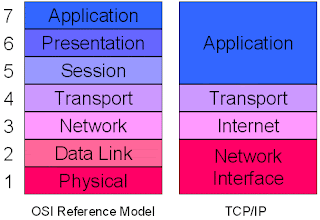TCP/IP Layers
no official model but a working one
- Application layer
- Host-to-host, or transport layer
- Internet layer
- Network access layer
- Physical layer
TCP/IP doesn’t have an “official” layer model (& it predates the OSI Reference Model we’ll introduce later), but it does have a “working” layer model, as shown.
Physical Layer
concerned with physical interface between computer and network
concerned with issues like:
- characteristics of transmission medium
- signal levels
- data rates
- other related matters
The physical layer covers the physical interface between a data transmission device (e.g., workstation, computer) and a transmission medium or network. This layer is concerned with specifying the characteristics of the transmission medium, the nature of the signals, the data rate, and related matters.
Network Access Layer
exchange of data between an end system and attached network
concerned with issues like :
- destination address provision
- invoking specific services like priority
- access to & routing data across a network link between two attached systems
- allows layers above to ignore link specifics
The network access layer is concerned with the exchange of data between an end system (server, workstation, etc.) and the network to which it is attached. The sending computer must provide the network with the address of the destination computer, so that the network may route the data to the appropriate destination. The sending computer may wish to invoke certain services, such as priority, that might be provided by the network. The specific software used at this layer depends on the type of network to be used; different standards have been developed for circuit switching, packet switching (e.g., frame relay), LANs (e.g., Ethernet), and others. Thus it makes sense to separate those functions having to do with network access into a separate layer.
Internet Layer (IP)
The internet layer provides procedures used to allow data to traverse multiple interconnected networks, to provide communications between devices are attached to different networks. The Internet Protocol (IP) is used at this layer to provide the routing function across multiple networks. This protocol is implemented not only in the end systems but also in routers. A router is a processor that connects two networks and whose primary function is to relay data from one network to the other on its route from the source to the destination end system.
Transport Layer (TCP)
The host-to-host layer, or transport layer, collects mechanisms in a common layer shared by all applications to provide reliable delivery of data. Regardless of the nature of the applications, there is usually a requirement that data be exchanged reliably, ensuring that all of the data arrives at the destination application and that the data arrives in the same order in which they were sent. These mechanisms for providing reliability are essentially independent of the nature of the applications. The Transmission Control Protocol (TCP) is the most commonly used protocol to provide this functionality.
Application Layer
Finally, the application layer contains the logic needed to support the various user applications. For each different type of application, such as file transfer, a separate module is needed that is peculiar to that application.
